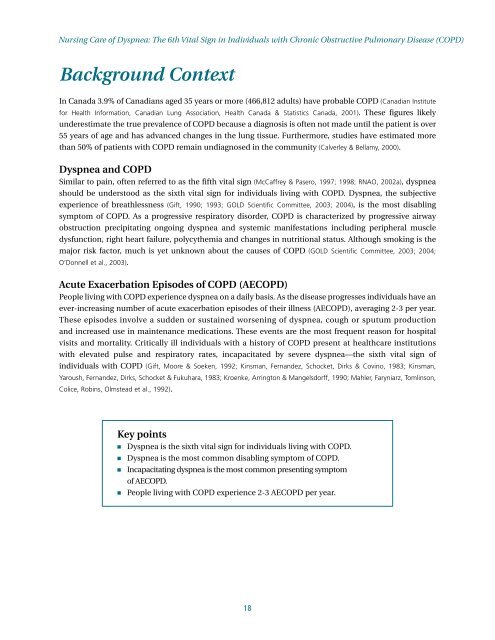Nursing Care of Dyspnea: The 6th Vital Sign in Individuals with ...
Nursing Care of Dyspnea: The 6th Vital Sign in Individuals with ...
Nursing Care of Dyspnea: The 6th Vital Sign in Individuals with ...
You also want an ePaper? Increase the reach of your titles
YUMPU automatically turns print PDFs into web optimized ePapers that Google loves.
<strong>Nurs<strong>in</strong>g</strong> <strong>Care</strong> <strong>of</strong> <strong>Dyspnea</strong>: <strong>The</strong> <strong>6th</strong> <strong>Vital</strong> <strong>Sign</strong> <strong>in</strong> <strong>Individuals</strong> <strong>with</strong> Chronic Obstructive Pulmonary Disease (COPD)Background ContextIn Canada 3.9% <strong>of</strong> Canadians aged 35 years or more (466,812 adults) have probable COPD (Canadian Institutefor Health Information, Canadian Lung Association, Health Canada & Statistics Canada, 2001). <strong>The</strong>se figures likelyunderestimate the true prevalence <strong>of</strong> COPD because a diagnosis is <strong>of</strong>ten not made until the patient is over55 years <strong>of</strong> age and has advanced changes <strong>in</strong> the lung tissue. Furthermore, studies have estimated morethan 50% <strong>of</strong> patients <strong>with</strong> COPD rema<strong>in</strong> undiagnosed <strong>in</strong> the community (Calverley & Bellamy, 2000).<strong>Dyspnea</strong> and COPDSimilar to pa<strong>in</strong>, <strong>of</strong>ten referred to as the fifth vital sign (McCaffrey & Pasero, 1997; 1998; RNAO, 2002a), dyspneashould be understood as the sixth vital sign for <strong>in</strong>dividuals liv<strong>in</strong>g <strong>with</strong> COPD. <strong>Dyspnea</strong>, the subjectiveexperience <strong>of</strong> breathlessness (Gift, 1990; 1993; GOLD Scientific Committee, 2003; 2004), is the most disabl<strong>in</strong>gsymptom <strong>of</strong> COPD. As a progressive respiratory disorder, COPD is characterized by progressive airwayobstruction precipitat<strong>in</strong>g ongo<strong>in</strong>g dyspnea and systemic manifestations <strong>in</strong>clud<strong>in</strong>g peripheral muscledysfunction, right heart failure, polycythemia and changes <strong>in</strong> nutritional status. Although smok<strong>in</strong>g is themajor risk factor, much is yet unknown about the causes <strong>of</strong> COPD (GOLD Scientific Committee, 2003; 2004;O’Donnell et al., 2003).Acute Exacerbation Episodes <strong>of</strong> COPD (AECOPD)People liv<strong>in</strong>g <strong>with</strong> COPD experience dyspnea on a daily basis. As the disease progresses <strong>in</strong>dividuals have anever-<strong>in</strong>creas<strong>in</strong>g number <strong>of</strong> acute exacerbation episodes <strong>of</strong> their illness (AECOPD), averag<strong>in</strong>g 2-3 per year.<strong>The</strong>se episodes <strong>in</strong>volve a sudden or susta<strong>in</strong>ed worsen<strong>in</strong>g <strong>of</strong> dyspnea, cough or sputum productionand <strong>in</strong>creased use <strong>in</strong> ma<strong>in</strong>tenance medications. <strong>The</strong>se events are the most frequent reason for hospitalvisits and mortality. Critically ill <strong>in</strong>dividuals <strong>with</strong> a history <strong>of</strong> COPD present at healthcare <strong>in</strong>stitutions<strong>with</strong> elevated pulse and respiratory rates, <strong>in</strong>capacitated by severe dyspnea—the sixth vital sign <strong>of</strong><strong>in</strong>dividuals <strong>with</strong> COPD (Gift, Moore & Soeken, 1992; K<strong>in</strong>sman, Fernandez, Schocket, Dirks & Cov<strong>in</strong>o, 1983; K<strong>in</strong>sman,Yaroush, Fernandez, Dirks, Schocket & Fukuhara, 1983; Kroenke, Arr<strong>in</strong>gton & Mangelsdorff, 1990; Mahler, Faryniarz, Toml<strong>in</strong>son,Colice, Rob<strong>in</strong>s, Olmstead et al., 1992).Key po<strong>in</strong>ts■■■■<strong>Dyspnea</strong> is the sixth vital sign for <strong>in</strong>dividuals liv<strong>in</strong>g <strong>with</strong> COPD.<strong>Dyspnea</strong> is the most common disabl<strong>in</strong>g symptom <strong>of</strong> COPD.Incapacitat<strong>in</strong>g dyspnea is the most common present<strong>in</strong>g symptom<strong>of</strong> AECOPD.People liv<strong>in</strong>g <strong>with</strong> COPD experience 2-3 AECOPD per year.18
















